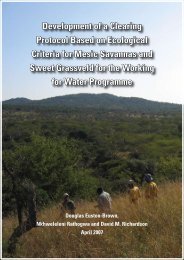Metsi Consultants - DWA Home Page
Metsi Consultants - DWA Home Page
Metsi Consultants - DWA Home Page
You also want an ePaper? Increase the reach of your titles
YUMPU automatically turns print PDFs into web optimized ePapers that Google loves.
10.1. PURPOSE OF SECTION<br />
Report No 678-F-001<br />
METSI CONSULTANTS: SUMMARY OF MAIN FINDINGS FOR PHASE 1 DEVELOPMENT<br />
SECTION 10. DISCUSSION OF SCENARIOS<br />
This section summarises the main findings of the IFR study and relates them to the design and possible operation<br />
of the LHWP Phase 1. This section and the succeeding one are framed so as to provide a bridge between the<br />
scientifically-designed and executed IFR study and the needs of decision-makers who will determine the ways<br />
and means of operating and further designing the LHWP. The design of the IFR study with its detailed biophysical<br />
and socio-economic comparison of scenarios that range from minimal environmental degradation, on one hand,<br />
to near-maximum diversion of system flows on the other, provides a comparative basis for drawing important<br />
conclusions on river ecosystem resilience and sustainability. The substantial biophysical and socio-economic<br />
database provided by the study furthermore provides a quantitative basis for comparative conclusions and for<br />
future refinement of IFR determinations.<br />
10.2. ISSUES RELEVANT TO THE TIMING OF THE IFR ASSESSMENT<br />
Under more ideal conditions the IFR study would have preceded major design and operating decisions for the<br />
LHWP. This was not the case, and the IFR study was commissioned well after the construction of Phase 1A and<br />
during the course of final design and initial construction of Phase 1B. A number of significant changes occurred<br />
between the mid-1980s, when Phase 1 of the LHWP was studied and designed and the LHWP Treaty formulated<br />
and signed, and 1997, when the IFR study was initiated.<br />
Phase 1 was designed and Phase 1A constructed on the assumption that downstream impacts resulting<br />
from diversion of more than 95% of the MAR would be limited to the proximal reaches of the<br />
Malibamats'o and Senqunyane rivers immediately downstream of the LHWP structures and above the<br />
confluences of the next major tributaries (Khohlontso and Semenanyane for the Malibamats'o, Lesobeng<br />
for the Senqunyane). This has been shown by the IFR study not to be necessarily the case.<br />
The assumption seems to have been made in the initial stages of the LHWP that local people make very<br />
little use of riverine and riparian resources downstream of the LHWP structures. No studies or<br />
assessments of these were conducted prior to the initiation of LHWP development. However, the IFR<br />
field studies have documented an extensive and sometimes complex relationship between local people<br />
and river-related resources such as riparian trees, shrubs and herbaceous species. Utilization of the fish<br />
resource along downstream river reaches by local people was not considered, whereas the IFR study<br />
has documented extensive fish harvesting and local trade in the downstream river reaches.<br />
The existing LHWP compensation programme addresses impacts only in the areas upstream of the<br />
LHWP structures. The IFR study has documented extensive existing and potential future economic<br />
impacts downstream of the structures.<br />
10.3. BIOPHYSICAL IMPACTS<br />
Table 10.1 summaries the predicted biophysical consequences of various levels of flow regulation for each of the<br />
study reaches. Reaches are separated into two classes - proximal (immediately downstream) to the LHWP<br />
structure and distant.<br />
51

















